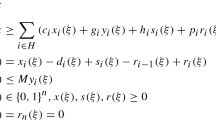Abstract
In this paper, we use integer programming (IP) to compute minimal forecast horizons for the classical dynamic lot-sizing problem (DLS). As a solution approach for computing forecast horizons, integer programming has been largely ignored by the research community. It is our belief that the modelling and structural advantages of the IP approach coupled with the recent significant developments in computational integer programming make for a strong case for its use in practice. We formulate some well-known sufficient conditions, and necessary and sufficient conditions (characterizations) for forecast horizons as feasibility/optimality questions in 0–1 mixed integer programs. An extensive computational study establishes the effectiveness of the proposed approach.
Similar content being viewed by others
References
Aronson, J. E., Morton, T. E. and Thompson, G. L.: A forward algorithm and planning horizon procedure for the production smoothing problem without inventory, Eur. J. Oper. Res. 15 (1984), 348–365.
Balas, E., Ceria, S. and Cornue´jols, G.: Mixed 0–1 programming by lift-and-project in a branch-and-cut framework, Manag. Sci. 42 (1996), 1229–1246.
Barnhart, C., Johnson, E. L., Nemhauser, G. L., Savelsbergh, M. W. P. and Vance, P. H.: Branch-and Price: Column generation for solving integer programs, Oper. Res. 46 (1998), 316–329.
Bastian, M. and Volkmer, M.: A perfect forward procedure for a single facility dynamic location relocation problem, Oper. Res. Lett. 12 (1992), 11–16.
Bean, J., Smith, R. L. and Yano, C.: Forecast horizons for the discounted dynamic lot size model allowing speculative motive, Nav. Res. Logist. Q. 34 (1987), 761–774.
Bensoussan, A., Crouhy, J. and Proth, J. M.: Mathematical Theory of Production Planning, Advanced Series in Management, North-Holland, Amsterdam, 1983.
Bes, C. and Sethi, S. P.: Concepts of forecast and decision horizons: applications to dynamic stochastic optimization problems, Math. Oper. Res. 13(2) (1988), 295–310.
Blocher, J. D. and Chand, S.: A forward branch-and-search algorithm and forecast horizon results for the changeover scheduling problem, Eur. J. Oper. Res. 91 (1996), 456–470.
Chand, S., Hsu, V. N. and Sethi, S. P.: Forecast, solution, and rolling horizons in operations management problems: a classified bibliography, Manuf. Serv. Oper. Manag. 4(1) (2002), 25–43.
Chand, S. and Morton, E.: Minimal forecast horizon procedures for dynamic lot size models, Nav. Res. Logist. Q. 33 (1986), 111–121.
Chand, S. and Morton, E.: A perfect planning horizon procedure for a deterministic cash balance problem, Manag. Sci. 28(6) (1982), 652–669.
Chand, S. and Sethi, S. P.: Planning horizon procedures for machine replacement models with several possible replacement alternatives, Nav. Res. Logist. Q. 29 (1982), 483–493.
Chand, S., Sethi, S. P. and Proth, J. M.: Existence of forecast horizon in undiscounted discrete-time lot size models, Oper. Res. 38(5) (1990), 884–892.
Daskin, M. S., Hopp, W. J. and Medina, B.: Forecast horizons and dynamic facility location planning, Ann. Oper. Res. 28 (1992), 125–151.
Federgruen, A. and Tzur, M.: Minimum forecast horizons and a new planning procedure for the general dynamic lot sizing model: nervousness revisited, Oper. Res. 42(3) (1994), 456–468.
Federgruen, A. and Tzur, M.: Fast solution and detection of minimal forecast horizons in dynamic programs with a single indicator of the future: applications to dynamic lot-sizing models, Manag. Sci. 41 (1995), 874–893.
Federgruen, A. and Tzur, M.: Detection of minimal forecast horizons in dynamic programs with multiple indicators of the future, Nav. Res. Logist. Q. 43 (1996), 169–189.
Grotschel, M., Junger, M. and Reinelt, G.: A cutting plane algorithm for the linear ordering problem, Oper. Res. 32 (1984), 1195–1230.
Johnson, R. E. and McClain, J. O.: On further results on planning horizons in the production smoothing problem, Manag. Sci. 24 (1978), 1774–1776.
Kleindorfer, P. and Leiber, Z.: Algorithms and planning horizon results for production planning problems with separable costs, Oper. Res. 27 (1979), 875–887.
Lundin, R. A. and Morton, E.: Planning horizon for the dynamic lot size model: Zabel vs. Protective procedures and computational results, Oper. Res. 23(4) (1975), 711–734.
Nair, S. K. and Hopp, W. J.: A model for equipment replacement due to technological obsolescence, Eur. J. Oper. Res. 63 (1992), 207–221.
Nemhauser, G. L., Savelsbergh, M. W. P. and Sigismondi, G. S.: MINTO, a mixed INTeger optimizer, Oper. Res. Lett. 15 (1994), 47–58.
Padberg, M. W. and Rinaldi, G.: Optimization of a 532-city symmetric travelling salesman problem by branch and cut, Oper. Res. Lett. 6 (1987), 1–7.
Rempala, R.: Forecast horizons in nonstationary Markov decision problems, Optimization 20 (1989), 853–857.
Rajagopalan, S.: Deterministic capacity expansion under deterioration, Manag. Sci. 38 (1992), 525–539.
Rajagopalan, S.: Capacity expansion with alternative technology choice, Eur. J. Oper. Res. 77 (1994), 392–403.
Sethi, S.: A note on a planning horizon model of cash management, J. Financ. Quant. Anal. 6 (1971), 659–665.
Sethi, S. P. and Bhaskaran, S.: Conditions for existence of decision horizons for discounted problems in a stochastic environment: a note, Oper. Res. Lett. 4(2) (1985), 61–64.
Wagner, H. M. and Whitin, T. M.: Dynamic version of the economic lot size model, Manag. Sci. 5(1) (1958), 89–96.
Author information
Authors and Affiliations
Corresponding author
Rights and permissions
About this article
Cite this article
Dawande, M., Gavirneni, S., Naranpanawe, S. et al. Computing Minimal Forecast Horizons:An Integer Programming Approach. J Math Model Algor 5, 239–258 (2006). https://doi.org/10.1007/s10852-005-9012-3
Published:
Issue Date:
DOI: https://doi.org/10.1007/s10852-005-9012-3




